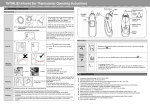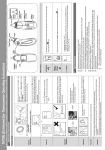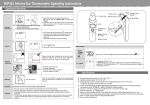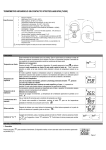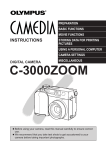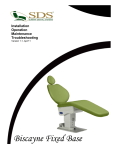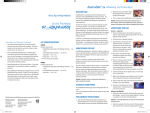Download Citizen CT830 Instruction manual
Transcript
REF CT830 IDENTIFICATION OF PARTS Probe lens Probe LCD Probe Cap "SCAN" button "ON/MEM" button Fig. 1 CITIZEN is a registered trademark of Citizen Holdings Co., Japan. CITIZEN es una marca registrada de Citizen Holdings Co., Japón. Design and Specification are subject to change without notice. 0801 English INSTRUCTION MANUAL for DIGITAL EAR THERMOMETER Warning English PLEASE READ THIS MANUAL BEFORE ANY ATTEMPT TO USE THIS PRODUCT IS MADE. PRECAUTIONS The ear thermometer must be inserted correctly to obtain correct temperature measurement. Be sure to consult a physician if you feel that your health is in poor condition. DO NOT judge your health only on the presence or absence of a fever. 1. Make sure that the probe lens is always clean. KEEP PROBE LENS CLEAN GOOD NOT GOOD 2. Very carefully and gently insert the probe into the ear. 3. Avoid using the ear thermometer if there is inflammation on or in the ear. 4. DO NOT use the ear thermometer if the main body is damaged (for example, the probe lens is broken). The continuous use of a damaged unit may cause injury, improper results, or serious danger. Contact a physician immediately if broken pieces are swallowed. Protect the natural environment: Please help protect natural environment by respecting national and/or local recycling regulations when disposing of the battery and the product at the end of their useful live. WEEE If you dispose this product, do not dispose of with general household waste. There are separate collection systems for used electronics products in accordance with legislation under the WEEE Directive (Directive 2002/96/EC), effective only within European Union. - Eng 2 - - Eng 3 - English Caution 1. The body temperature measured in the ear may differ from measurements taken under the armpits, in the mouth, or in the rectum. Therefore, comparing them will not be of value. Take temperature readings periodically to determine the normal ear temperature measurement with this instrument, then use that reading as the basis for comparison with any measurement taken when you suspect a fever. 2. Do NOT use this thermometer for measurements other than as specified. This thermometer is designed for ear measurement. Room temperature and material surface temperature readings are approximate and are only for reference. 3. Do NOT immerse the ear thermometer in water or any other liquid and do NOT allow the unit to come into contact with chemical solvents. 4. Do NOT drop the ear thermometer and do NOT expose the ear thermometer to heavy shock. The ear thermometer is not shock-protected. 5. Do NOT bend the ear thermometer. 6. Do NOT disassemble the unit, do NOT make any modifications to it, and do NOT touch the circuitry. 7. Do NOT store the unit under the direct sunlight, do NOT store it at high temperatures, and do NOT store it in areas with a high degree of humidity and/or dust. 8. Do NOT boil the probe. 9. Do NOT use the ear thermometer if it operates irregularly or shows signs of malfunction. 10. Do NOT use thinner or benzene to clean the ear thermometer. 11. When removing the ear thermometer from storage at low temperatures, place it in a warm area for 5 to 10 minutes before use. 12. Keep the ear thermometer out of the reach of children. 13. Wipe the ear thermometer clean before storing. English About Ear Thermometers All objects radiate heat. To measure body temperature, this ear thermometer uses an infrared sensor incorporated in its probe to detect the heat radiated from the eardrum and the area around it. In general the ear canal (external auditory canal) of an infant is relatively straight. As we grow older, it takes on some curvature, as shown in Fig. 2. It is important to point the probe lens of the ear thermometer toward the eardrum and its periphery inside the ear. To straighten the ear canal, gently pull on the outer ear in the direction of the rear of the head, as shown in Fig. 3. Each ear canal has a slightly different shape, be sure to check it before taking temperature readings. Insert the probe straight into the ear canal, as shown in Fig. 4. Fig.2 Fig.3 Fig.4 Caution 1. A person’s left and right ear canals are not necessarily symmetrical. This may cause different measurement results. Always take temperature readings in the same ear. 2. A soiled probe lens will result in inaccurate measurement. Be sure to check that the probe lens is clean before use. 3. Body temperature rises after vigorous exercise, a bath or shower, or eating. Wait at least 30 minutes before taking temperature readings. 4. Do NOT use the ear thermometer when the ear canal is wet (after swimming, bathing, etc.). 5. Let the ear thermometer stand at room temperature before use. 6. It is important to know your normal temperature so you can compare it to the measurement result. - Eng 4 - FUNCTIONS This thermometer has the following functions for care of users. • Ear Temperature: for human temperature. • Time and calendar: for memory. • Room Temperature: for monitoring the ambient temperature for a baby or patient. • Material surface temperature (NOT for body temperature): for temperature of a baby's milk, etc. • Stop watch: for taking a patient's pulse. • Fever alarm: an alarm when a user's temperature is more than 37.5°C, indicative of a fever. • Memory: for recording up to 9 temperature readings. • Celsius / Fahrenheit option switch: for international use. TIME AND CALENDAR SETTINGS 1. Press and hold the ON/MEM button for about 5 sec and the icon starts to flash, indicating the setting mode (Fig.5). Date/Time (24/12-hour display) Fig.5 2. Press the SCAN button for the 12/24-hour setting mode. The icon starts to flash, indicating the 24-hour display. Press the SCAN button again and the 24 icon will disappear from the screen, indicating the 12-hour display. When this display is used, afternoon times will be indicated with the PM icon. Press the SCAN button to toggle between the 12 and 24-hour displays. 3. Press the ON/MEM button to cycle the flashing icons in the sequence below to select the respective setting. hoursminutessyearsmonthsdaysleave the setting screen While the setting section is flashing, press SCAN button to change the numbers. If no buttons are pressed in the setting mode for 8 seconds, the display automatically returns to the EAR TEMPERATURE mode. - Eng 5 - English HOW TO OPERATE English EAR TEMPERATURE 1. Make sure that the probe lens is clean. 2. Press ON/MEM button and after the all indicators show up on the display (Fig.6), the ready message with icon displays, accompanied by two short beeps (Fig.7). Fig.6 Fig.7 3. Gently pull the ear back to straighten the ear canal (Fig.3) and gently position the probe into the ear canal, aiming towards the membrane of the eardrum to obtain an accurate reading. 4. After the probe is positioned in the ear, press and hold the SCAN button until you hear one beep. The measurement is now complete. Remove the probe and read the temperature on the display (Fig.8). (Ear temperature mark) Fig.8 NOTE: The time and calendar settings should be done before measurement readings are taken. The thermometer always shuts off automatically in about one minute and the stand-by mode display (room temperature and date/time) will be shown. Without the time and calendar settings, the display will not show any indications after the thermometer shuts off. Pressing the buttons will NOT shut off the thermometer. ROOM TEMPERATURE = STAND-BY MODE 1. Set the TIME AND CALENDAR FIRST. Then the stand-by mode display will appear after the automatic shut-off. 2. When in stand-by mode, the room temperature will always appear on the display with the icon (Fig.9). (Room temperature mark) Fig.9 - Eng 6 - MATERIAL SURFACE TEMPERATURE / STOP WATCH 1. Make sure that the probe lens is clean. 2. Press ON/MEM button to enter the EAR TEMPERATURE mode. 3. MATERIAL SURFACE TEMPERATURE: Press and hold the ON/MEM button and then press the SCAN button once to leave the EAR EMPERATURE mode and enter the MATERIAL SURFACE TEMPERATURE scan icon (Fig.10). mode with (Material surface temperature mark) Fig.10 3.1 Aim the probe torward the material and press the SCAN button, and the material surface temperature appears on the display. To measure the temperature of another material, repeat the procedure. If the SCAN button is pressed and held, the measurement reading will be continuously updated. 3.2 Applications include temperature measurements for water, milk, cloth, etc. Press and hold the ON/MEM button and then press the SCAN button once to leave MATERIAL SURFACE TEMPERATURE mode and enter the STOPWATCH mode with the icon (Fig.11). NOTE: * Do NOT submerge the probe tip in liquid. * This mode shows the surface temperature of material only and is NOT for taking human body temperature. - Eng 7 - English 3. The room temperature is renewed every minute. After measuring body or material surface temperature, the sensor may be warm which may affect the room temperature reading. Therefore during the first 15 minutes after every use, the room temperature on the display may be inaccurate. English 4. STOP WATCH: (Stop watch mark) Fig.11 4.1 This mode counts from 0.01sec to 3 minutes. 4.2 To start and stop the stopwatch, press the SCAN button. To reset the counter, press the ON/MEM button. Press and hold the ON/MEM button and then press the SCAN button once to leave STOP WATCH mode and return to the EAR TEMPERATURE mode. FEVER ALARM If the thermometer detects a temperature over 37.5°C in the EAR TEMPERATURE mode, there will be a long beep followed by three short beeps to warn the user of a fever. MEMORY There are a total of 9 memory slots for recording EAR TEMPERATURE measurements. Each memory slot also records the date and time of the measurement. Memory slots can be cycled by pressing the ON/MEM button during the EAR TEMPERATURE mode (Fig.12). (Memory mark) Fig.12 NOTE: Even when a Memory slot is being displayed, users can measure ear temperature. CELSIUS/FAHRENHEIT OPTION SWITCH 1. Make sure the thermometer is in stand-by mode and indicating the room temperature, date, and time. 2. Press and hold the SCAN button, then immediately press the ON/MEM button. After 3 seconds, the °C icon will switch to the °F icon. (use same procedure to switch back to °C). - Eng 8 - If this unit is left unattended for about 1 minute, it will automatically power down from the current mode and enter the stand-by mode, showing room temperature, time, and date. The display alternates between time and date in a pattern that repeats every minute as follows: time 11 sec / date 4 sec / time 11 sec / date 4 sec / time 30 sec. BATTERY REPLACEMENT 1. Replace the battery when the display behaves as follows: The stand-by mode shows NOTHING on the display except the time and date. When the ON/MEM button is pressed, NOTHING is displayed except the battery mark blinking 12 times followed by OFF for 1 second and then the display returns to NOTHING except the time and date. s ON/MEM s s s 2. Insert a pointed object such as a pen into the battery cover access hole (Fig.13) while using your thumb to push the battery cover out. Fig.13 3. Hold the device and pry the battery out with a small screwdriver (Fig.14). Fig.14 4. Insert a new battery (CR2032) under the metal hook and press down on the battery until you hear a click. The positive (+) side should be up and the negative (-) side should be down. 5. Replace the battery cover. - Eng 9 - English AUTO POWER OFF FUNCTION English Caution 1. Remove and then reinstall the battery if the Er message is displayed, if the display is abnormal, or if nothing is displayed when the ON/MEM button is pressed. 2. To protect the environment, dispose of the used battery according to local regulations. 3. Remove the battery if the ear thermometer will not be used for a long time. 4. Keep the battery away from children. CARE AND CLEANING, STORAGE The probe is the most delicate part of the thermometer. Use caution when cleaning the probe lens to avoid damage. Holding the thermometer too long may cause the probe to make a higher ambient temperature reading. This could make the body temperature measurement lower than usual. • After each use, clean the probe and probe lens with a cotton swab or soft cloth moistened with 70% alcohol. • Let the lens fully dry for at least 30 minutes. • Keep the unit dry and away from where it might be exposed to moisture, liquids, direct sunlight, high temperature, high humidity, or excessive dust. • Storing the thermometer at 10 to 40°C (50 to 104°F) allows you to measure body temperature at any time. Storing the thermometer below or above this temperature range may cause it to display Er 3. In such a case, leave the thermometer at 10 to 40°C (50 to 104°F) for at least 30 minutes before taking a measurement reading. - Eng 10 - DESCRIPTION OF DISPLAY MARK Meaning Measurement before device stabilization. The device showing a rapid ambient temperature change. The ambient temperature is not within 10 to 40°C (50 to 104°F). The system is not functioning properly. (1) Ear temperature mode: Temperature taken is higher than + 42.2°C (108°F). (2) Material surface temperature mode: Temperature taken is higher than + 80°C (176°F). (1) Ear temperature mode: Temperature taken is lower than + 34°C (93.2°F). (2) Material surface temperature mode: Temperature taken is lower than - 22°C (- 7.6°F). Device cannot be powered on to the ready stage. - Eng 11 - Corrective action Wait until all the icons stop flashing. Allow the thermometer to rest for at least 30 minutes at a room temperature between 10 and 40°C (50 to 104°F) Remove the battery, wait for 1 minute, and reinsert it. If the message reappears, contact the retailer where you purchased the thermometer for service. The thermometer might have measured the temperature of a nearby object that it was not designed to measure. If the malfunction persists, please contact the retailer where you purchased the thermometer. Change the battery. English Message English Questions and Answers Q1: Why is temperature measured in the ear different from measurements taken under the armpit, in the mouth, or in the rectum? A1: Temperatures of different parts of body may vary. Compare the measurement in question with a normal temperature previously taken in the same ear. Q2: The temperature differs each time I take a measurement. Why? What can I do? A2: Your method for straightening the ear canal may be inconsistent, the way you insert the probe may be not consistent, or you may be taking a second measurement too soon. Pull the ear rearward to straighten ear canal, then very gently insert the probe into the ear canal for measurement. Once a measurement is taken, the temperature in the ear will be affected. Therefore, wait at least 1 minute before taking another measurement. Q3: Can I measure temperature without the probe cover? A3: This instrument is designed to measure temperature without the probe cover. Do NOT attach the probe cover or any film or covering. Q4: Is it hygienically safe to use the ear thermometer without the probe cover? A4: The probe and probe lens should be kept clean by using a cotton swab or soft cloth moistened with 70% alcohol. Therefore, the thermometer can be used hygienically without the probe cover. Q5: Can I use the ear thermometer in cold/hot places? A5: This instrument can be used in room temperature from 10 to 40°C (50 to 104°F). Error messages (Er 2 or Er 3) may be displayed if the temperature during storage greatly differs from that of the room temperature where you take a measurement reading. In such a case, let the ear thermometer stand for a while at room temperature before measurement. Q6: Can I use the ear thermometer on an infant? Their ear canals are very small. A6: Do NOT attempt to force the probe into the ear canal. Use caution and pay close attention while very gently inserting the probe just into the entrance of ear canal. Q7: Can I use the ear thermometer to measure temperature under the armpit or in the mouth? A7: No. This instrument is designed to measure temperature only in the ear. Q8: Can I use the ear thermometer on animals? A8: No. This instrument is designed to measure temperature in the ears of humans. - Eng 12 - SPECIFICATIONS For Ear temperature mode 34.0~42.2°C (93.2~108°F) For Material surface temperature mode -22~80°C (-7.6~176°F) Accuracy: For Ear temperature mode ±0.2°C (0.4°F) for temperatures 35.5~42.0°C (95.9~107.6°F). ±0.3°C (0.5°F) for other ranges. For Material surface temperature mode ±0.3°C (0.5°F) for temperatures 22~42.2°C (-7.6~108°F) for other ranges. ±4% or ±2°C (4°F), whichever is greater. Display: 3 digits with decimal point Battery mark Ear temperature mode Material surface temperature mode Stopwatch Memory °C or °F Battery: One lithium cell battery (CR2032 X 1 pc) Battery life: 3000 consecutive measurements or 1 year with 1-2 measurements per day including stand-by mode. Rated Voltage: DC3V ( : Direct Current) Operating temperature range: 10~40°C (50~104°F) Storage temperature range: -20~50°C (-4~122°F) Transportation temperature range must be less than 70°C. Unit size: 115 (L) X 37 (W) X 29 (H) mm Weight: Approx. 60g (including battery) Electric shock protection: Internal power unit Safety classification: Type BF equipment Memory: 9 memory slot recall function Attention, consult accompanying documents. * Specifications may be changed without notice in the event of improvements being made. Reference standard: Complies with ASTM E1965-98, EN12470-5: 2003 Clinical thermometers-Part 5: Performance of infra-red ear thermometers (with maximum device), IEC60601-1-2(EMC), EN60601-1(Safety) standards. Manufacturer: Name: Radiant Innovation Inc. Address: 1F, No.3, Industrial East 9th Road, Science-Based Industrial Park, HsinChu, Taiwan 300. European Representative: Name: Medical Technology Promedt Consulting GmbH Address: Altenhofstrasse 80, D-66386 St. Ingbert, Germany - Eng 13 - English Measuring Range: REF CT830 IDENTIFICATION OF PARTS Probe lens Probe LCD Probe Cap "SCAN" button "ON/MEM" button Fig. 1 CITIZEN is a registered trademark of Citizen Holdings Co., Japan. CITIZEN es una marca registrada de Citizen Holdings Co., Japón. Design and Specification are subject to change without notice. 0801 English INSTRUCTION MANUAL for DIGITAL EAR THERMOMETER














